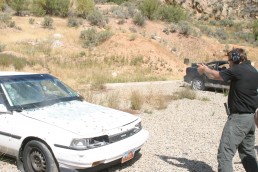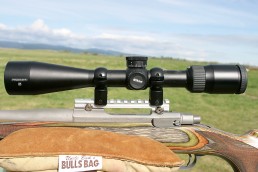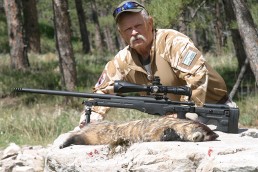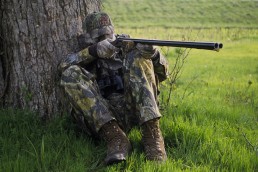An Education for Those Who Carry
SHARE THIS POST
Times are changing in the world of concealed carry, and as many sportsmen do indeed carry when not afield, there are some updates as to what is being taught and required of police officers regarding weapons training today. The subject is glass and lots of it. Officers have been ambushed in their squads and citizens have been fired on while driving to work in the morning. All these active shooting situations tend to involve vehicle window glass, and as such, there are interesting facts that could save your life.
It may come as a surprise to some, but motor vehicle glass is a very effective barrier against bullets. In some cases, they can be just about bulletproof. Windshields are actually separated by a thin film of plastic that acts as a bonding agent and allows the glass to separate intact when impacted bullets tend to bounce off this surface, one that’s of course curved in the first place. Any time a facing surface to a bullet retains an angle versus a flat surface, a bullet or projectile’s penetrating ability is minimized greatly.
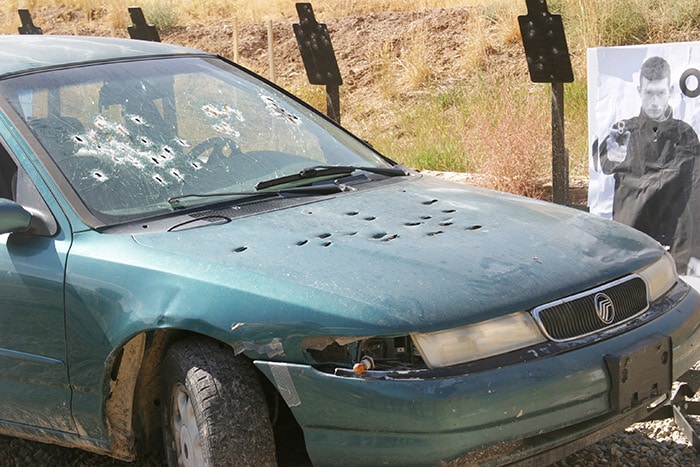
Last fall, I was a guest of Action Target, out of Salt Lake City, Utah. Action was offering a police-training course to officers that included a detailed section that dealt with staying alive when confronted by a sniper or a direct-shooting situation while confined within a patrol car. The training involved the use of motor vehicles that were set up with removable windscreens so that if these windscreens were shot to pieces they could be quickly replaced and used for the next group of officers. They placed Action Target’s steel hardened plate targets around the vehicle, representing the bad guys trying to advance on the squad car as officers defend their position by shooting directly through the windshield.
I’m sure you’re wondering why I’m writing about this subject? Well, as stated earlier, many outdoorsmen tend to carry firearms and many continue to carry when out of the backcountry. More and more often vehicles are being involved in live-fire situations and currently there are many thugs shooting homeowners directly through their front doors. Here, or in a barricade situation, a glass storm door is involved. “Do what you need to do” has been talking about aggressively to eliminate this threat.
During the Action three-day school, over 100 officers from many agencies across Utah and Wyoming came together to upgrade their skill levels. The learning curve was massive, and very sharp-edged. Aside from sniper school, entry tactics and others, the vehicle defensive shooting course was very well received, as this is an issue many officers and civilians face on our streets. I have addressed the large number of officers that came from many different departments because, for the most part, everyone was carrying a different weapon or at least different types of ammunition. What this did was present a very unique training and test event when all the varied weapon and cartridges were applied to the program. In effect, all guns and loads don’t shoot alike, and the differences that were presented in real-time against real material targets were massive to say the least. And unlike some issues set to ink that don’t offer much a solution or just report on the problem, this training program did and does open windows to solid solutions to the problems of failed bullets against hard surface material.
I have written material regarding barricade penetration and bullet contamination years ago. No one wanted it at the time, and it was considered “boring” as a subject. But it’s not boring today, as both civilians and police officers are seeing the effects motor shootings and home invasions. With this background in mind, there are additional solutions for those who carry and want to defend themselves, even when trapped in a vehicle with their duty or personal service gun in hand.
Are you enjoying this post?
You can be among the first to get the latest info on where to go, what to use and how to use it!
Bullets are one of the keys to addressing this problem, and not so much the caliber or make of your weapon. What was found during the several days of training and testing was that even the small 9 mm Luger could defeat window glass with the right bullet at hand. If you shoot a 9 mm—many, if not most folks do now—pay attention to this observed performance result regarding a specific bullet. Be advised, though, many bullets failed to even make it through a windshield both from the inside the vehicle and when fired directly at the outside surface—only one bullet in the 9 mm passed the course. That bullet was the 147-grain H.P. Speer Gold Dot. After seeing this bullet cut through the windscreen from the inside out and then smack the Action Target steel torso center mass, I, like many of the officers present, were taken aback a bit by this spectacle. With that knowledge, police officers can develop a vehicle evacuation plan during live-fire conditions, and know that the bullet will have a direct affect on advancing “warm targets” (a nice term for your basic dirt bag.)

After observing the performance of the Speer Gold Dot, I’ve made some changes to my carry order of ammunition and now alternate my Winchester Black Talon with the Speer Gold Dots in both of my eight- round magazines. My weapon that is carried a whole lot of the time locally is a SW M&P Shield 3-inch single- stack auto. While there were some detailed drills applied to train officers, I don’t feel obliged to go into that area, especially with officer safety so much in question in our country today. I will say that when firearms use is required by the citizen carrying a gun and that individual is confined within a vehicle, try to shoot low through the windshield, as a bullet fired inside or out will pass though and hit high all the time. Why this is? I have no idea. But we observed this over the course of many windscreens on vehicles used during the training, and with repetition of hundreds of rounds downrange through glass. Setting the Action steel targets just ahead of the vehicle’s hood and shooting near the lower third of the windscreen would produce hits on the target torso. Higher placed shots passed around or over the head of the steel targets.
Other methods of defeating window glass are moving to heavy guns. Yes, bigger is better in this case, and the good old-school 1911 45 Government rained king in this case. Officers shooting 45s did the deed every time. Heavy 200-grain+ pills smashed straight though the windscreen glass, as well as out the back windows. Wheel guns have gone away to a greater extent—save for the 357 Smith Model 66 Combat Magnum I carry often—so I tend to believe that the 41 Mag, 44 Mag, and heavy bullet 357s would turn the trick nicely in this case.
When I’m on the road I carry my Smith and Wesson Pro Series 1911 3-inch barrel 45 ACP. The gun is compact to carry, but a bit heavy. I like it on the road, as I know I will not be walking much. But I also know I have one pile of firepower at hand quickly. It’s interesting that when I trained and went to school for my 38 state carry permit through South Dakota I was the only guy on the line of 15 that carried a wheel gun for qualification. The S&W 66 Combat Magnum gave off the distinctive double-tap crack of +P ammunition, and I had the attention of a line full of shooters with autoloader with the first series of rounds downrange. My point is that times have changed, and shooters that carry need to stay up with what is new and what can save your bacon in a real gun fight.
As an outdoorsman you’re likely saying this does not apply to you. My friends, at a very active age of 75, I can say for a fact that I’ve been involved in no fewer than three major incidents over my life in the great outdoors that required the display of my handheld weapon: deep-swamp deer theft (attempted), tractor-driving crazy with a shotgun disputing my trap line location and five not-so-nice folks on the road in the mountains of Wyoming who wanted to kill me or steal my truck and eventually didn’t want any part of my Smith Model 29 .44 Magnum. The last incident could have well involved window glass-barrier issues. Stick around long enough, and bad stuff will happen. In fact, I’d have to say the whole subject has never been as big a problem as it is today.
MWO
SHARE THIS POST
Did you enjoy this post?
You can be among the first to get the latest info on where to go, what to use and how to use it!
L.P. Brezny
Writing on outdoor subjects for over 40 years, L.P. Brezny has written four books on shotgun and rifle (ballistics and performance). He’s an expert at smoothbore, and high-power, ultra-long-range shooting. He’s a specialist, producing reviews covering general products used in the outdoors industry.
